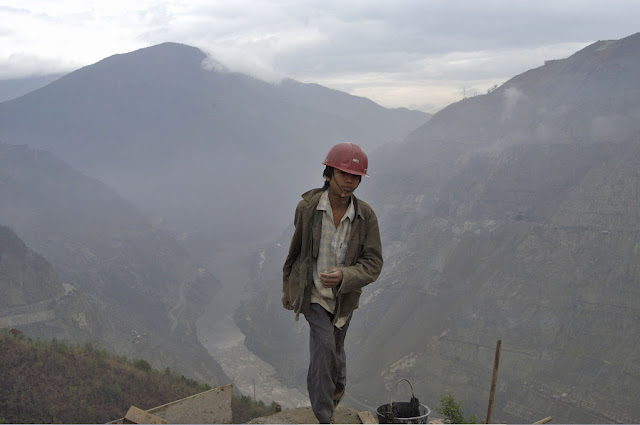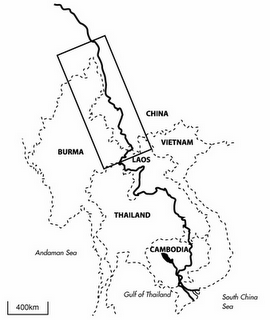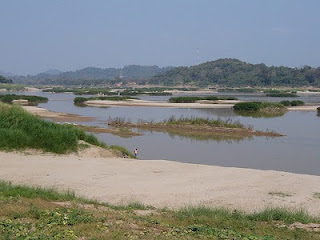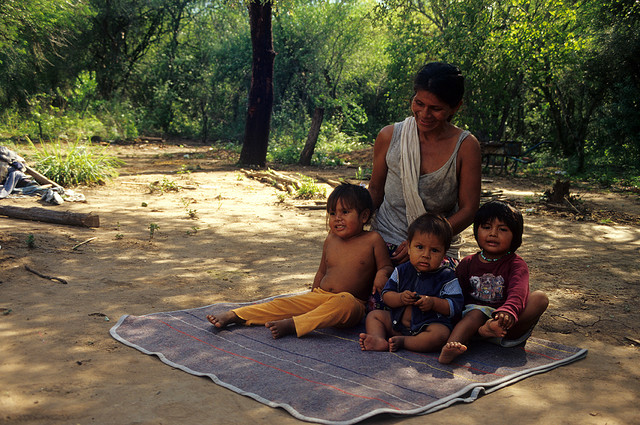Showing posts from category energy.
-
Emily Gertz, Momentum Magazine
U of M’s ‘Momentum’ on Water Scarcity, Population, and Climate Change
›December 20, 2010 // By Wilson Center StaffExcerpted from the original article, “Water Tight,” by Emily Gertz in the University of Minnesota’s Momentum magazine.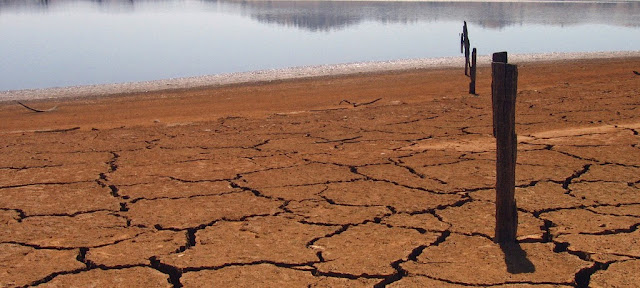
The next time you stop off at a pub for a quick bite, think about this: It took around 630 gallons of water to make your burger. Your pint of beer used around 20 gallons. Manufacturing your blue jeans and t-shirt drank up about 1,218 gallons of water: 505 and 713 gallons, respectively.
Total: nearly 1,900 gallons of water – and that’s without fries on the side.
These quantities are the “water footprint” of each product: the total amount of freshwater used in its manufacture, including producing the ingredients.
For many products, that footprint is Paul Bunyan–sized: With water seemingly cheap and plentiful, there has been little incentive to try to keep it small.
But today, that’s changing. Even though much of the water we use for growing food and making products is replenished by natural hydrological cycles, freshwater will be less reliable and available in the coming century. Population growth is increasing both demand for water and pollution of potable supplies. At the same time, climate change is disrupting historical precipitation patterns, shrinking freshwater sources such as glaciers and snowpack, and creating unprecedented droughts and floods.
According to an analysis published in Nature in September 2010, the freshwater supplies of most of the world’s population are at high risk.
“If you look at the global distribution of people and the global distribution of threat levels to human water security, the places with the highly threatened water security represent about 80 percent of the world population, over four billion people,” says study co-author Peter McIntyre, assistant professor at the University of Wisconsin’s Center for Limnology.
In the United States, a 2010 analysis by the consulting firm Tetra Tech for the Natural Resources Defense Council found that more than 1,100 counties – fully two-thirds of all counties in the lower 48 states – will contend with higher water risk by 2050 due to climate change alone. Fourteen states can expect extremely serious problems with freshwater supply, including Florida, Mississippi, New Mexico, and California.
It’s not surprising, then, that businesses are increasingly considering their corporate water footprint. They encounter water risk – and opportunities to reduce it – at many stages of their operations, from growing crops to running retail stores. Factoring such risks into their present and future planning is helping companies present themselves as good environmental stewards to the public, and potentially reduce risks to their earnings from water scarcity.
“It’s often said that water is going to be the oil of the 21st century, in the sense of becoming an ever-more scarce commodity,” McIntyre says. “In the grand scheme of things, you can live without oil, but you can’t live without water. Water is fundamental for all life. And that’s certainly true for business as well.”
Continue reading on Momentum.
Sources: Natural Resources Defense Council, Nature.
Photo Credit: Adapted from “Lake Hume at 4%,” courtesy of flickr user suburbanbloke. -
Joydeep Gupta, ChinaDialogue
Nervous Neighbors: China-India Water Relations
›December 3, 2010 // By Wilson Center StaffExcerpted from the original article, “Nervous Neighbors,” on ChinaDialogue.net:
Only five rivers in the world carry more water than the Yarlung Zangbo, or Brahmaputra, as it is known when it reaches India. Only one carries more silt. Rising at a height of 5,300 meters in the Kailash range of the Middle Himalayas – an area holy to both Hindus and Buddhists – the river flows east through Tibet for 1,625 kilometers before taking a horseshoe bend, changing its name and flowing as the Brahmaputra into north-eastern India.
There, for 918 kilometers, it is both a lifeline, due to the water it carries, and a scourge, because of the floods it causes almost every year. It then takes a southward turn and flows into Bangladesh for 363 kilometers before it merges with the Ganges, together forming South Asia’s largest river, the Meghna, and flowing into the Bay of Bengal. This huge river, with its 25 large tributaries in Tibet and 105 in India, drains much of the eastern Himalayas.
As the world’s youngest mountain range, the Himalayas are particularly unstable – and so is the river. It has changed its course significantly at least once in the last 200 years, following a major earthquake. Smaller changes in course are common, wiping out farms and homes on one bank while depositing fertile silt on the other. Now humans are changing the course of this river: Chinese engineers have started to build the Zangmu hydroelectric power station in Lhoka prefecture, 325 kilometers from Lhasa, Tibet’s capital. The development has led to serious expressions of concern, particularly in India but also in China.
Continue reading on ChinaDialogue.net.
Joydeep Gupta is the project director (South Asia) of ChinaDialogue’s Third Pole Project.
Map Credit: Google Maps. -
Managing the Mekong: Conflict or Compromise?
›December 1, 2010 // By Russell SticklorAt nearly 5,000 kilometers long, the Mekong River is one of Asia’s most strategically important transboundary waterways. In addition to providing water for populations in the highlands of southern China, the Mekong helps support some 60 million people downstream in Southeast Asia, where the river is a key component of agricultural production and economic development.
In recent years, however, the Mekong has emerged as a flashpoint for controversy, pitting China against a coalition of downstream nations that includes Thailand, Laos, Cambodia, and Vietnam. The countries of the Lower Mekong argue that Beijing’s construction of multiple dams on the Upper Mekong is robbing them of critical water resources, by decreasing both the quality and quantity of water that makes it through Chinese floodgates and spillways. China, however, mindful of soaring energy demand at home, has continued its campaign to harness the hydroelectric potential of the Upper Mekong and its tributaries – but at what cost to the environment and Beijing’s relationships with Southeast Asia?
China’s Hand on the Faucet
China’s total energy demand just recently passed the United States and is expected to continue to increase in the near-term – by 75 percent over the next 25 years, according to the International Energy Agency.
As a result, Beijing has been looking to bolster its energy security by reaching out to develop energy resources in Africa, Latin America, and the Middle East, as well as along the Mekong and in the East and South China Seas.
In that context, China’s aggressive hydroelectric development of the Upper Mekong — known in China as the Láncang Jiang (shown in the boxed area of the map at right) — makes perfect sense. The river’s sizeable elevation drops make it a rich source of energy; already, 15 large-scale dams have either been completed or are under construction on the Upper Mekong in Tibet and Yunnan.
Those dams also provide China with enormous geopolitical leverage over downstream nations. With little more than the flick of a switch, the Chinese government could substantially curtail the volume of flow entering the Lower Mekong basin. Doing so would of course be tantamount to an act of war, since depleted flow volumes in the Lower Mekong would hinder crop irrigation, jeopardize food security, and endanger the health of the region’s economically critical freshwater fisheries, which are among the world’s most productive. Chinese floodgates and spillways essentially give Beijing de facto control over Southeast Asia’s water security.
The View Downstream
To date, China has never threatened to deliberately reduce the flow of the Mekong to its downstream neighbors. Nevertheless, the perception of threat in Southeast Asian capitals remains high.
Already, a number of the region’s governments — represented formally through the Mekong River Commission, a 15-year-old organization that China still has not joined as a full-fledged member — have complained that completed or in-progress Chinese dams are resulting in less water entering their countries, a phenomenon that becomes particularly pronounced during periods of drought, as observed this summer. Further, there is also the issue of water quality. Since Chinese dams trap silt being flushed out of the Himalayas, that nutrient-rich material cannot be carried downstream, where it historically has helped create fertile soils in the floodplains of the Lower Mekong basin.
Quality and quantity concerns aside, there are also structural issues concerning how Beijing goes about its business on the Upper Mekong. Since it is only a “Dialogue Partner” to members of the Mekong River Commission, China is not required to seek approval from downstream nations on hydroelectric development of the river’s Chinese stretch, even though that development has both direct and indirect implications for water security in the Lower Mekong basin. China has even shown a penchant for deliberate secrecy as it develops its stretch of the river, choosing to share a minimal amount of hydrological data with downstream neighbors and typically refraining from even announcing new dam projects.
“The Security Implications Could Hardly Be Greater”
Given its geographic position, Cambodia is particularly vulnerable to China’s stewardship decisions. With one of the poorest populations in Southeast Asia and also one of the highest fertility rates, at 3.3 births per woman, the potential for water scarcity issues is real. By mid-century, its population is projected to jump from its current 15 million to nearly 24 million.
“The government of Cambodia will be entirely at the mercy of Beijing,” said Wilson Center Scholar and Southeast Asian security expert Marvin Ott. “For Cambodia, the question becomes how they can curry China’s favor so as to avoid coercive use of the Mekong — or find some way of exerting counter-pressure on Beijing.”
Overall, population for mainland Southeast Asia is projected to rise from its current 232 million to 292 million by 2050. This growth will require increased agricultural output across the region and thus increased reliance on the waters of the Lower Mekong. The Lower Mekong nations’ shared dependency on the river and China’s continued unilateralism in the Upper Mekong could have serious repercussions for the region, said Ott:The security implications could hardly be greater for the downstream states. With the dams, China will have literal control over the river system that is the lifeblood of Laos, Cambodia, and Vietnam. The power this gives China is equivalent to an invasion and occupation of a country by the Chinese army.
For its part, the PRC maintains that water woes in the Lower Mekong are not its doing. In response to the chorus of Southeast Asian claims that China diverts or stores more than its fair share of water, Beijing’s typical refrain has been that blame for low water levels downstream lies not with Chinese water resource management but with heightened precipitation variability associated with climate change. Chinese water officials also contend that the Lower Mekong countries’ complaints are misdirected because water from the Chinese-controlled sections of the Upper Mekong basin accounts for less than 20 percent of the Mekong’s total flow volume by the time the river reaches its natural outlet in the South China Sea.
There are some indications, however, that China may be experimenting with a more open approach to engaging downstream nations. Earlier this year, China overturned precedent by offering top Southeast Asian government officials a tour of what had once been a top-secret hydro project, the mammoth Xiaowan dam. Some critics insisted Beijing’s fear of growing U.S. influence in the Lower Mekong helped motivate the rare show of transparency, while others said it was a means to curry favor with Southeast Asian nations so that they would support China’s controversial resource-development strategies in the South China Sea. Yet regardless of motive, Beijing’s move away from secrecy – if sustained – could do a great deal to smooth over regional tensions.
Dammed If You Do, Damned If You Don’t
Beyond some limited transparency, Beijing also hopes to mitigate concerns about development of the Upper Mekong by offering funding or logistical support for similar large-scale hydroelectric facilities on the Lower Mekong. The move has been largely welcomed by the Mekong River Commission countries, which envision dams of their own generating much-needed energy input for national grids, accelerating continued economic modernization, and enhancing flood control. As of 2009, there were 12 dam projects for stretches of the Mekong south of the Chinese border and many more planned for key tributaries.
The danger in such deal-making is that the environmental costs will be lost in the shuffle. A series of major dams would fundamentally alter the Mekong’s hydrology, which could lead to the degradation of sensitive riverine ecosystems, the disruption of upstream migratory routes for fish that serve as local dietary staples, and the decline of fresh water fisheries that form the backbone of many local economies.
Given the long-term effects on the food, environmental, and economic security of the Lower Mekong heartland, Beijing’s attempt to ease water tensions with a new round of dam construction may end up doing far more harm than good. Unfortunately, with both China and the Mekong River Commission countries currently viewing the dam proposals as something of a win-win, planning and construction are likely to move forward over the coming years.
Sources: Financial Times, Foreign Policy, International Institute for Strategic Studies, Los Angeles Times, Mekong River Commission, National Geographic, New Asia Republic, Phnom Penh Post, Population Reference Bureau, Stimson Center.
Photo Credits: “Xiaowan Dam Site (Yunnan Province, China, 2005),” (Top) courtesy of flickr user International Rivers; Map (Middle) courtesy of International Rivers; “Thailand – Isaan, Mekong River,” (Bottom) courtesy of flickr user vtveen. -
Robert Walker on Family Planning Promotion and Global Population Growth
› “Expanding voluntary family planning access and ensuring that all women have access to reproductive health services is, to me at least, a no brainer,” said the Population Institute’s Robert Walker in this interview with ECSP. “I think it’s a win for women, for their health, for their welfare, the welfare of their families, for their communities, for the environment, and for the planet at large.”
“Expanding voluntary family planning access and ensuring that all women have access to reproductive health services is, to me at least, a no brainer,” said the Population Institute’s Robert Walker in this interview with ECSP. “I think it’s a win for women, for their health, for their welfare, the welfare of their families, for their communities, for the environment, and for the planet at large.”
While China and India dominate much of the global headlines about population growth, other parts of South Asia – namely Afghanistan and Pakistan – and sub-Saharan Africa receive comparatively little attention. For Walker, a renewed global effort to boost the quality and quantity of reproductive healthcare tools and services in these areas of the developing world is essential.
“This is very, very doable. We face a lot of really incredible challenges in the world today, particularly with respect to food, energy, water, and poverty. But if we can increase what we spend on international family planning assistance by three or four billion dollars a year, we can literally change the world,” Walker said. “And I think we desperately need to.”
The “Pop Audio” series is also available as podcasts on iTunes. -
What’s Good for Women Is Good for the Planet
›Ammi, my mother-in-law, was 16 years old when her marriage was arranged. Before she was 18, she had borne her first child, who died within the year, and by 30, she had given birth to six more. She had a fourth-grade education, and like other women in the new state of Pakistan, she knew little about contraceptive choices.
More than 50 years later, contraception still remains inaccessible for millions of women in Pakistan, such as Rani, the young woman who cleans Ammi’s Karachi home. Illiterate and married off to a cousin at age 15, Rani already has three children, and, like the majority of married Pakistani women who have never used modern contraception, will most likely have at least one more.Giving women the ability to determine whether and when to become pregnant is fundamental to the realization of their basic human rights. It is also a proven health and development strategy, substantially reducing maternal and infant mortality by allowing women to space their pregnancies. And now, for the first time, two studies offer compelling evidence that it has another benefit: What is good for women is also good for our planet.
These groundbreaking studies have rigorously quantified the effect on the environment of helping women and girls control their reproductive destinies. The studies – “The World Population Prospects and Unmet Need for Family Planning,” by the Futures Group, and, “Global Demographic Trends and Future Carbon Emissions,” by the National Center for Atmospheric Research and the International Institute for Applied Systems Analysis – demonstrate that giving women and girls access to contraception offers a precious co-benefit: a substantial reduction in carbon emissions.
The logic is simple: When women have the power to plan their families, populations grow more slowly, as do greenhouse gas emissions. The cost of providing these needed family planning services worldwide is minimal compared with other development and emissions reductions strategies – roughly $3.7 billion per year.
More than 200 million women in the United States and developing countries are sexually active and do not want to become pregnant, yet are not using modern contraception. The results are staggering: One in four births worldwide is unplanned, leading to 42 million abortions each year (half of them clandestine) and 68,000 women’s deaths.
Moreover, the large number of women who become pregnant when they do not want to is a significant source of population growth. Read in tandem, the studies show that a reduction of 8-15 percent of essential carbon emissions can be obtained simply by providing modern contraception to all women who want it. This reduction would be equivalent to stopping all deforestation or increasing the world’s use of wind power 40-fold. Although this is just one piece of the emissions reduction puzzle, it is a substantial piece.
The world is now facing multi-layered challenges of economic distress, rising inequality, and environmental devastation caused by climate change. International climate negotiations have repeatedly stalled as powerful nations play the blame game and block progress. Meanwhile, a series of severe weather events has buffeted the earth from Moscow to Iowa to Pakistan, each one hitting women and children hardest. This is the reality that rich nations must reckon with – and commit to changing – today.
In my 14 years at the Global Fund for Women, I have observed the wave of change that comes from empowering women – what some call the “girl effect.” Making information, education, and contraception easily available offers us an affordable, no-regrets strategy that can be implemented now.
Meeting the need for family planning services is not a complex challenge. We know how to provide the commodities, services, and education that women and their families want. There are thousands of programs around the world with successful track records in every conceivable religious, cultural, and political setting.
Investing in family planning has already been proven as an essential strategy to ensure the health, safety, and development of societies. Now we know that it is also an effective way to safely steward Mother Earth through one of her most challenging crises.
Kavita N. Ramdas is chair of the Expert Working Group of the Aspen Institute’s Global Leaders Council for Reproductive Health and senior adviser and former president and CEO of the Global Fund for Women.
Sources: Futures Group, National Center for Atmospheric Research and the International Institute for Applied Systems, Science, UNFPA, WHO.
Photo Credit: “Chaco: Madre pilagá,” courtesy of flickr user Ostrosky Photos, and Kavita Ramdas, courtesy of Global Fund for Women. -
Governing the Far North: Assessing Cooperation Between Arctic and Non-Arctic Nations
›November 12, 2010 // By Ken CristDespite fears of an unregulated race for Arctic territory and resources, there is currently considerable international cooperation occurring to address key issues in the Far North, said Betsy Baker of the Vermont Law School at an event hosted by the Canada Institute in collaboration with the Friedrich Ebert Foundation, the Kennan Institute, and the Environmental Change and Security Program. The program provided a timely forum to discuss efforts by Arctic and non-Arctic nations to cooperate on key environmental, security, and economic issues, and foster discussion on pressing Arctic governance questions. The event’s first panel was moderated by Don Newman, former senior parliamentary editor, CBC News.
Assessing Cooperation Among Arctic Nations
The United States, said Baker, is currently engaged in international cooperation in a number of areas including, shipping, emergency response and rescue, science, seabed mapping, and joint military exercises. The majority of U.S. Arctic initiatives are conducted via the Arctic Council, an institution that Secretary of State Hillary Clinton favors strengthening. Baker maintained that the most effective form of Arctic governance would be a “bottom up” approach. Governing structures closest to the end users, she explained, are the most effective means of ensuring economic development and environmental security.
Baker noted that the lack of infrastructure and search and rescue capabilities represent the most pressing security concerns in the Arctic. Until this occurs, the international community will not be able to adequately respond to a potential oil spill or grounded vessel in the region. While some analysts have expressed concern over the militarization of the Arctic, Baker and other panelists downplayed the possibility of military conflict in the Far North as a significant concern. She suggested that science-based diplomacy would be the best means to peacefully resolve disputes in the region.
Danila Bochkarev of the EastWest Institute in Brussels said that the development of sea routes (particularly the Northern Sea Route), border protection, and infrastructure development are among Russia’s top Arctic priorities. Bochkarev noted that the Arctic region has increased in economic importance to Russia and currently represents 11 percent of its GDP and 80 percent of the country’s discovered industrial gas. Aside from economic opportunities, melting Arctic ice has also allowed increased access to Russian territory, which is also viewed as a security concern by Russian officials. Other looming Russian concerns, noted Bochkarev, include the increasing internationalization of Arctic governance, competing claims for the Arctic continental shelf, and challenges to Russia’s sovereignty claim over the Northern Sea Route. He maintained that Russia has committed to following the principles of the UN Convention on the Law of the Sea to peacefully resolve any territorial disputes.
Joël Plouffe of the Université du Québec à Montreal noted that Canada’s recently published “Statement on Canada’s Arctic Foreign Policy” highlights the Harper government’s desire to bolster economic development, protect the environment, strengthen its sovereignty claim, and improve governance in the Far North. Plouffe said that the Arctic policy document also shows Canada’s commitment to foster bilateral relationships among Arctic nations, particularly the United States. He noted that Canada has always promoted international cooperation in the Arctic and was one of the founding members of the Arctic Council. Canada’s Arctic policy, said Plouffe, also serves to fill a security gap in the Far North, an area of particular concern to the United States.
While Canada has demonstrated a willingness to engage coastal Arctic states on key environmental, security, and economic issues in the Far North, the Canadian government’s willingness to work with non-Arctic states is less clear, said Plouffe. Canada, he remarked, has yet to decide whether it would like to create an exclusive neighborhood of Arctic states to resolve governance issues, or if it is willing to include non-Arctic nations in international meetings and Arctic forums.
The Perspective of Non-Arctic Nations
“[W]e cannot be indifferent to a region whose melting ice sheet, volumes of water, and temperatures have a direct impact on Germany and Europe,” said Franz Thönnes, SPD Member of the German Bundestag. He explained that Germany and the European Union’s interest in the Arctic stem in part from the importance the EU places on the principles of stability and sustainability. EU interests in the Arctic also extend to the economic realm. Of particular interest, said Thönnes, are untapped Arctic oil and gas reserves and potential new shipping routes. He noted that the shipping route from Hamburg to Shanghai would be cut from 25,200 km to 17,000 km should the Northwest Passage become accessible. Given that Germany operates the world’s largest container fleet, access to such routes would be of major importance to Germany and other European maritime countries.
Ted McDorman of the University of Victoria stated that from an international law perspective, the Arctic Ocean is legally no different than any other ocean. Like other oceans, noted McDorman, there are significant gaps in governance that will require international cooperation to address. These include setting standards for shipping vessels passing through Arctic water and waterways, collaboration on marine science, and how to manage the Arctic marine ecosystem sustainably. According to McDorman, while some aspects of Arctic oil and gas development, such as drilling, will fall under domestic jurisdictions, international standards will still need to be negotiated to address potential oil spills or other environmental repercussions that may affect other countries. McDorman questioned whether an international treaty modeled after the Antarctic treaty would make sense for the Arctic region and he echoed comments by others that the idea is not supported by key Arctic players and is unlikely to move forward.
The Scandanavian countries vary in their level of Arctic engagement, said Timo Koivurova of Finland’s University of Lapland. Finland is currently developing a new Arctic strategy, and Iceland remains adamantly opposed to an exclusive Arctic Five governance structure while supporting active EU involvement in Arctic affairs. On the other hand, Sweden remains relatively inactive on the Arctic policy front. Koivurova noted that there are a growing number of non-Arctic nations – including China, South Korea, and Japan – that are seeking to become a part of the Arctic Council.
Koivurova closed by asking whether the Arctic Council could be reformed in a manner that allowed Arctic nations to retain their status while allowing greater representation for non-Arctic nations. Such reform, said Koivurova, may be necessary given the increasing desire and number of countries vying for a voice on Arctic governance.
Ken Crist is program associate with the Canada Institute at the Woodrow Wilson Center.
Photo Credit: “Arctic Sunrise,” courtesy of flickr user drurydrama (Len Radin). -
Rare Earths Intrigue: In Response to Chinese Ban, Japan and Vietnam Make a Deal
›November 2, 2010 // By Schuyler NullThe BBC is reporting that Japan has reached an agreement with Vietnam that will help provide a secure supply of rare earth minerals, after China reportedly stopped exports to Japan during an ongoing territorial dispute last month.
China produces nearly all (97 percent, according to the GAO) of the rare earth minerals used around the world, minerals that are used in many advanced electronics including mobile phones, missiles, and key components of cleaner energy tech. Japanese companies are expected to gain exclusive exploration and mining rights in northwest Vietnam in exchange for technical assistance on nuclear reactors.
China’s reported export freeze on rare earths raised warning flags in the region as well as in Washington, where fears over exclusive supply of the crucial minerals have been growing for some time – particularly in the defense community. (Although Bloomberg reports a new Pentagon study says it’s not such a big deal after all.) Control over and access to resources has become an important concern in East Asian diplomacy, as population and consumption in the region rises. For more, check out The New Security Beat’s coverage of the many diplomatic fault lines at play between the lower Mekong countries, China, and the United States, rare earth minerals and green energy, and the conflict potential of future resource scarcity.
Sources: BBC, Bloomberg, Government Accountability Office, The New York Times, TechNewsDaily.
Image Credit: Adapted from “The Huc Bridge, Hanoi,” courtesy of flickr user -aw-. -
Energy and Climate Change in the Context of National Security
›“Climate Change and Security,” a short briefing by Paul Rogers of the Oxford Research Group, examines the recent trend of framing climate change in terms of a national security threat and presents some of the pros and cons of this viewpoint. Rogers says the recent uptick in interest by the military is expected – and welcomed – because military planners often perform more long-term analyses than other policymakers. However, Rogers also cautions that the military, in its role as protector of the state, will naturally focus on adapting to the effects of climate change rather than preventing them. Thus, while this willingness to think long-term is appreciated, work remains to convince the international security community of the importance of carbon-cutting measures as well.
“Fueling the Future Force: Preparing the Department of Defense for a Post-Petroleum Era,” by Christine Parthemore and John Nagl of CNAS, is a comprehensive policy paper arguing for the U.S. military to aim for the ability to operate all its systems on non-petroleum fuels by 2040. Parthemore and Nagl outline a broad set of recommendations that address DOD’s consumption habits, leadership structure, finances, acquisition process, and mission goals. Notable, in the context of Paul Rogers’ warning, is that the authors’ argument is essentially one of supply and demand, rather than for cutting emissions to reduce the effects of climate change: “…while many of today’s weapons and transportation systems are unlikely to change dramatically or be replaced for decades, the petroleum needed to operate DOD assets may not remain affordable, or even reliably available, for the lifespans of these systems.”


